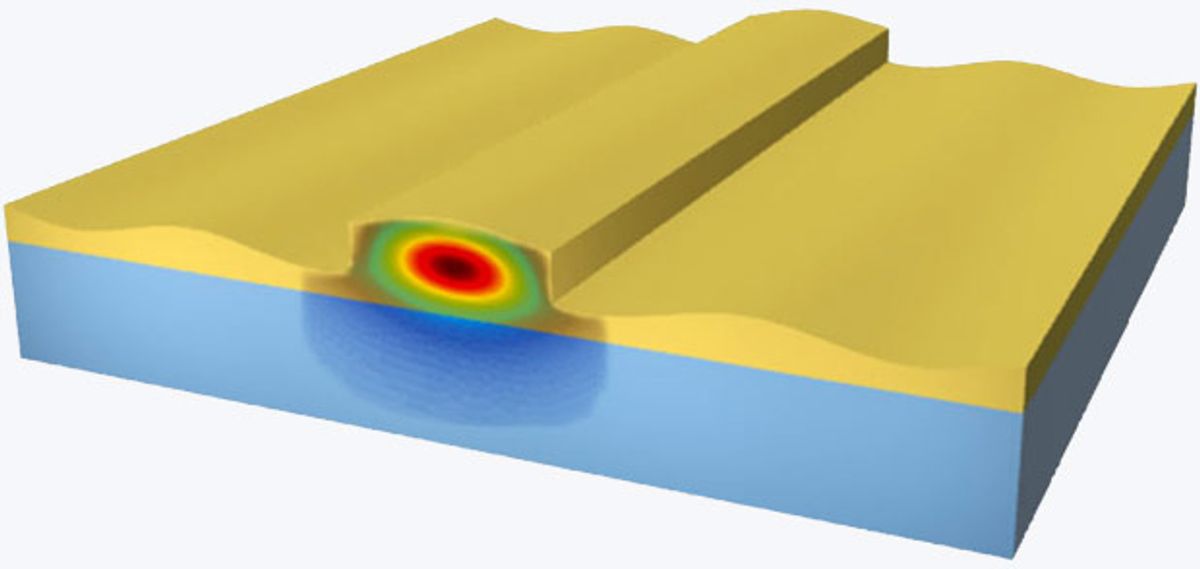Sound is widely used for modulating light in optical communications or for controlling the output of lasers. The devices designed to do this, acousto-optic modulators, typically contain a crystal attached to a piezoelectric transducer. The sound waves propagating through the crystal modulate the intensity of light passing through it. But these devices are typically the size of a sugar cube, so integration with photonic chips is difficult. Also, their acoustic frequencies, limited to the megahertz range, make them unsuitable for high-speed optical communications.
Now, two researchers at the University of Minnesota have reported, in Nature Communications, how they overcame the frequency limitations of the transducer. They did it by reducing the size of the acoustic modulator and by integrating a nanophotonic circuit with the piezoelectric transducer on a single chip.
The logical approach was, of course, to look for a material with both good optical and piezoelectric properties. They used aluminum nitride, a piezoelectric material that fits the bill perfectly. It can easily be sputtered on silicon dioxide, has a high refractive index, and is a good conductor of sound waves. They deposited a 330-nanometer-thick layer of this material on a silicon wafer, then etched away some of the material to form a rib waveguide. The waveguide is a closed loop shaped like a racetrack; light is allowed to circulate around the elongated circle. A tiny piezoelectric interdigital transducer comprising parallel gold lines deposited on the aluminum nitrate emits sound waves in one of the racetrack’s straightaways.
Because the gold lines in the transducer are only about 100 nanometers wide, they can generate sound waves with frequencies as high as 10 gigahertz.
“What is new in this research is that we reduce the wavelength of the sound wave to be even smaller than the wavelength of light,” says Mo Li, a coauthor of the paper and head of the electrical and computer engineering department’s nanophotonics and nanomechanics lab. The sound waves set up a traveling region of lower and higher density in the material; this region acts like a diffraction grate, bending the light sideways. Because the period of the grate is smaller than the wavelength of the light, the diffraction is very efficient.
This is not the only advantage of the on-chip design. The sound waves are, unlike conventional acoustic modulators, not bulk waves, but surface waves. “We do everything on a surface, and this is why we achieved a strong interaction between the sound and light,” Says Li.
Because they injected light into the racetrack and allowed it to resonate, the researchers were able to modulate the intensity of the light efficiently by injecting a 10-GHz signal into the acoustic wave transducer. Li explains that converting a microwave signal into modulated light will greatly increase the distance over which data-carrying microwaves can be transmitted. The light can transport the microwaves over much longer distances in optical fiber, with much lower signal loss and at a much lower cost, than transmitting them directly through air, says Li. “You only need a photodetector that can convert the light back into microwaves,” he adds.
With the recent breakthroughs in research into plasmons—surface waves of electrons induced by light on conducting surfaces—these waves’ interaction with acoustic surface waves might be an interesting new direction. “The challenge is to further reduce the sound wave to be of the same order as the wavelength of surface plasmon waves,” says Li. “This is not impossible, and you might find some interesting effects,” he says, adding that because both the sound waves and plasmons are surface waves, you will have a perfect overlap.
Now the researchers’ goal is to increase the frequency of the sound waves to 20 GHz. Such higher frequencies will open up interesting possibilities for quantum computation, says Li. Sound waves will allow the coupling of optical qubits (photons) with phonons. Optical qubits are good for the transmission of data, while phonons, which arise at very low temperatures, are better suited for quantum processing.



